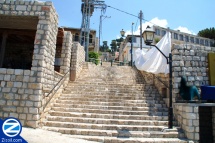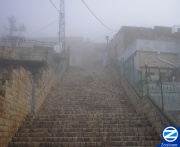Maalot HaGardom Great Stairs Safed
(→Ma’alot Oleh HaGardom) |
|||
| (3 intermediate revisions by 2 users not shown) | |||
| Line 1: | Line 1: | ||
| − | [[File: | + | {{Infobox |
| + | |title = Great Stairs of Tzfat | ||
| + | |image = [[File:00000299 big tzfat staircase.jpg|215px|alt=Great Stairs of Tzfat]] | ||
| + | |header1 = Hebrew: | ||
| + | |data2 = מעלות עולה הגרדום | ||
| + | |header3 = Pronunciation: | ||
| + | |data4 = Ma’al-ot O-leeh Ha’Gar-dom | ||
| + | |header5 = Other Names: | ||
| + | |data6 = Great Tzfat Stairs, Dividing Safed Stairs | ||
| + | |header7 = Translation: | ||
| + | |data8 = Stairs of the Ascendants to the Scaffold | ||
| + | |header9 = Description: | ||
| + | |data10 = Historic stairway which divides Tzfat’s Old Jewish Quarter and Artist Quarter named for pre-State martyrs.}} | ||
Maalot HaGardom Great Staircase of [[Safed]] is a long stairway which consists of several hundred stairs separating the [[Old City Safed|Old City]] and the [[Artists Quarter Safed|Artists Quarter]], running through the middle of the city's tourist bus parking lot. Both the stairway and its name are rooted in [[Safed History|Tzfat history]]. | Maalot HaGardom Great Staircase of [[Safed]] is a long stairway which consists of several hundred stairs separating the [[Old City Safed|Old City]] and the [[Artists Quarter Safed|Artists Quarter]], running through the middle of the city's tourist bus parking lot. Both the stairway and its name are rooted in [[Safed History|Tzfat history]]. | ||
== British Rule == | == British Rule == | ||
| − | After the First World War the [[British Rule of Safed 1918 to 1948|British]], who had defeated the [[Ottoman Rule of Safed 1760 to 1918|Ottoman Turks]], accepted responsibility for ruling the area called “Palestine.” The British created a Mandate which declared that they would rule until the local population could govern itself. | + | [[File:00000122 great staircase safed rainy day.jpg|thumb|180px|left|The Staircase on a rainy day.]]After the First World War the [[British Rule of Safed 1918 to 1948|British]], who had defeated the [[Ottoman Rule of Safed 1760 to 1918|Ottoman Turks]], accepted responsibility for ruling the area called “Palestine.” The British created a Mandate which declared that they would rule until the local population could govern itself. |
Many local Jewish residents resented the British rule, especially as time passed and the British policies became openly pro-Arab. The Arabs refused to allow the Jews to arm themselves for self-defense purposes and limited Jewish immigration to Palestine, even in the face of growing anti-semitism in Europe. | Many local Jewish residents resented the British rule, especially as time passed and the British policies became openly pro-Arab. The Arabs refused to allow the Jews to arm themselves for self-defense purposes and limited Jewish immigration to Palestine, even in the face of growing anti-semitism in Europe. | ||
| Line 25: | Line 37: | ||
== Ma’alot Oleh HaGardom == | == Ma’alot Oleh HaGardom == | ||
Following the [[Safed War of Independence|War of Independence]] the city administration of Tzfat renamed the stairway the “Ma’alot Oleh HaGardom” in memory of the men who were hung by the British for their struggles in the name of Jewish independence. | Following the [[Safed War of Independence|War of Independence]] the city administration of Tzfat renamed the stairway the “Ma’alot Oleh HaGardom” in memory of the men who were hung by the British for their struggles in the name of Jewish independence. | ||
| + | |||
| + | |||
| + | {{Safed History}} | ||
| + | {{Safed Tourism}} | ||
[[Category:Safed]] | [[Category:Safed]] | ||
[[Category:Jewish History]] | [[Category:Jewish History]] | ||
Latest revision as of 19:24, 10 February 2013
Maalot HaGardom Great Staircase of Safed is a long stairway which consists of several hundred stairs separating the Old City and the Artists Quarter, running through the middle of the city's tourist bus parking lot. Both the stairway and its name are rooted in Tzfat history.
Contents |
[edit] British Rule
After the First World War the British, who had defeated the Ottoman Turks, accepted responsibility for ruling the area called “Palestine.” The British created a Mandate which declared that they would rule until the local population could govern itself.Many local Jewish residents resented the British rule, especially as time passed and the British policies became openly pro-Arab. The Arabs refused to allow the Jews to arm themselves for self-defense purposes and limited Jewish immigration to Palestine, even in the face of growing anti-semitism in Europe.
[edit] Underground Organizations
Several Jewish underground organizations were formed to try to defend the Jewish community of Palestine, facilitate illegal Jewish immigration and harass the British. These organizations differed in ideology but a few of them, including the Stern Gang and the Irgun, believed that the British were as much of a threat to the Jews’ aspirations for independence as the Arabs. Their military actions were aimed as much as driving the British out as to prepare for eventual war with the Arabs.
[edit] Hangings
The British sentenced several young men, members of the Irgun and the Stern Gang, to death for their actions against the British. These men were hung at the prison in Acco (Acre). The British buried them in the small cemetery in Tzfat, reasoning that it would be more difficult for followers to use these remote gravesites as rallying points. The Jews set aside a special section of the Safed cemetery for these men and called them the “Oleh HaGardom” -- Ascendants to the Gallows.
[edit] Stairs
The stairway, which divides the Jewish Quarter and the Artist Quarter of Tzfat, was built after the 1929 Arab riots when Arabs from Tzfat’s Arab Quarter invaded the Jewish Quarter and killed, wounded and pillaged the Jews living in the quarter. The ruling British forces built the stairway and trained spotlights on the stairs to prevent further incursions and mayhem.
[edit] Location
The stairs run from Jerusalem Street, the main commercial street above the Old City and Artists Quarter, down to Keren HaYesod Street which runs above the Tzfat cemetery. There are over 300 stairs on the stairway.
[edit] Separation
During the period of the British Mandate the British erected searchlights at the top of the stairs on Jerusalem Street and trained them on the staircase. British sentries guarded the stairs to prevent Arabs from crossing into the Jewish Quarter. For the most part, this was successful, but there were some incursions that resulted in murders of Jews in the Jewish Quarter.
[edit] Ma’alot Oleh HaGardom
Following the War of Independence the city administration of Tzfat renamed the stairway the “Ma’alot Oleh HaGardom” in memory of the men who were hung by the British for their struggles in the name of Jewish independence.
| ||||||||||||||
| |||||||||||||||||



